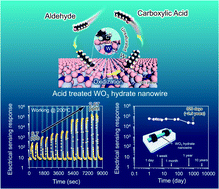A thermally robust and strongly oxidizing surface of WO3 hydrate nanowires for electrical aldehyde sensing with long-term stability†
Abstract
Electrical molecular nanosensors require two conflicting surface characteristics, which are catalytic activity for molecular selectivity and thermal stability for long-term data collection. Here, we show that a simple surface treatment using strong acids creates two such conflicting surface properties of WO3 hydrate nanowires, which enhance the electrical molecular sensing of aldehydes (nonanal, a biomarker). Mass-spectrometric measurements reveal that the surface treatment using strong acids substantially promotes both the oxidization of nonanal and the desorption of products, nonanoic acid, from the surfaces at a temperature of 50 °C, which is lower than the 300 °C required for untreated surfaces. Spectroscopic and structural measurements combined with numerical simulations identify two different adsorption structures of carbonyl groups on the surface, where molecules directly bound to coordinatively unsaturated surface tungsten preferentially proceed to the catalytic oxidization reaction and the subsequent desorption process. Furthermore, we confirm the thermal durability (over 10 years) of the catalytic activity on acid-treated WO3 hydrate nanowire surfaces up to 300 °C, which enables us to demonstrate the long-term stable sensor operations with the sensitivity (4 orders of magnitude) remaining for years.



 Please wait while we load your content...
Please wait while we load your content...